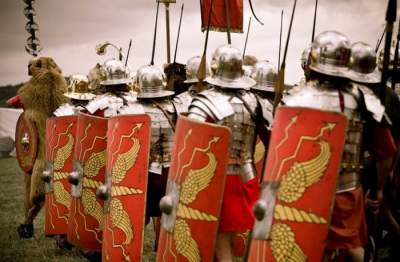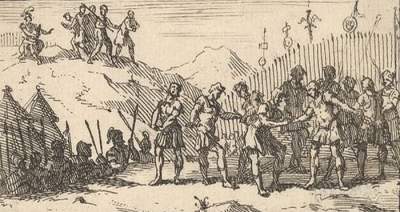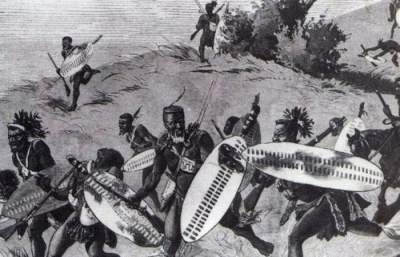 The all-conquering Roman army was famous for its efficiency and discipline.
The all-conquering Roman army was famous for its efficiency and discipline.
A small country on the Apennine Peninsula the rule in most parts of the Western world: from the British Isles to the Middle East, from the Rhine to North Africa. In our review of the interesting facts about the Roman army, which may explain its successes and failures.
1. Seasons of war

During the early history of the Romans there was some problem in the conduct of war — sowing and harvesting. The economy of Rome was based on agriculture and therefore, as he wrote Livy (History of Rome, 5.6), “if the war was not finished by the end of summer, the soldiers had to make a break for the whole winter “. He also mentioned that the soldiers usually spent the winter, engaged in hunting.
2. Decimation

Mutinies of the troops has always been a potential problem for the Roman generals, so there are many ways to prevent it. The most effective and brutal of these methods has been the decimation (execution of every tenth by lot). In a military unit, in which case mutiny, every tenth person was stoned or clubbed to death. Whenever the rebels within the army was planning a rebellion, the prospect of decimation would cause them to think twice.
3. Privilege, or responsibility?

Military service was both a duty and privilege of Roman citizens. At first the Roman army was composed exclusively of citizens and was organized on the basis of their social status (in accordance with weapons and uniforms, which people could afford). The richest served in the cavalry, poorer people have served in the infantry, and people who did not own any property and were expelled from the army.
After the Second Punic war (218-201 BC) this system of recruitment has changed. Rome began to take part in longer and more global war and needed a permanent military presence in the newly conquered territories. Thus, the property qualification was lowered. In the second century BC and the property qualification was reduced even more. Then, in 107 BC, Gaius Marius began to accept volunteers who have not had at any property and equipped them at the expense of the government.
4. Defensive squads

Whenever the Romans besieged the city, they sent a special military unit to surround the village to prevent any escape. Near the besieged city had established a fortified camp (and, in the distance, which did not reach the walls of the boom). This military unit was supposed to destroy the defensive walls with catapult and shoot the archers, leading the barrage.
5. Tunnels

Tunnels was the key moment of the siege. The failure or success of many sieges were resolved by how well the Romans could Wade through the defensive wall, often digging tunnels under the city. Although this was an effective tactic, this trick has become widely known to the enemies of Rome, and in the end lost his element of surprise.
During the war against Mithridates of Pontus at the beginning of the first century BC, the Romans tried to dig a tunnel to breach the defences Themyscira. Residents Themyscira issued in response to the tunnel the number of dangerous wild animals, including bears and even bees. The oldest archaeological evidence of chemical warfare dates back to the third century of our era. We are talking about the tunnels in Syria, where were found evidence of an underground battle between the Romans and the Sassanid Persians.
The Persians besieged the Roman garrison and began to dig tunnels to break the defense. The Romans replied that they started to dig tunnels towards to neutralize the attackers. Skeletons and weapons found in one of these tunnels indicate that Roman soldiers were killed under the ground, choking in the cloud of suffocating gas which proceeded from the bitumen and sulphur crystals, set on fire by the Persians.
6. The function of the helmet

According to some ancient authors, the helmets of the Roman army had other advantages besides their obvious protective function. Polybius (“Histories”, 6.23) indicated that the decorations on the top of the helmets had a psychological effect on the enemy because they are Roman soldiers in them looked scary, plus they added the soldiers of growth. Use decorations of the helmet to intimidate enemies was widely practiced by most cultures.
7. The procedure for a Declaration of war

During the Roman Republic, only the Senate (the government organization that was used for the expression of Roman citizens) had the right to declare war. But Rome was expanding, and the power of his army grew, so some of the wars the Roman military leaders began to declare without Senate approval. An example of this was the war against Mithridates VI of Pontus, which was announced in 89 BC, Consul Manius Aquilam without any involvement on the part of the Senate. When Rome became an Empire, the decision to declare war is given only the Emperor.
8. Family

In Rome, was a specialized Agency of the priests, known as family, the sole duty of which was to perform the rituals associated with war. The final step in the ritual of declaring war was a throwing spear into enemy territory. The beginning of the third century BC, Rome expanded significantly, taking almost the entire Apennine Peninsula and throwing a spear into enemy territory was mildly inappropriate. The priests came up with an alternative. Part of the land near the temple of Bellona (goddess of war) was declared and not the Roman spear was thrown at her.
9. The Spanish Gladius

The standard short sword that was used in the Roman army, was known as the Gladius hispaniensis (Spanish sword), and it was developed in the Iberian Peninsula. Its deadly efficiency and practicality was legendary. As he wrote Livy (“History of Rome”, 31.34), when the Romans fought against Philip V during the Macedonian war (200-196 BC), the Macedonians were shocked by the wounds from the Roman swords.
10. Gift

The Praetorian guard was a specialized unit of the Roman army, which acted as the “home troops” of the Emperor and his personal bodyguards. During the first century BC the Praetorian guard sometimes was involved in the process of appointment of new emperors. But time passed, their participation in public life increased and in the end, the Praetorians were in a position where they were able to appoint, remove and even kill the Roman emperors. One of the motivations for the murder of the Emperor and the appointment of the new practice was known as “deed of gift” – a significant award, which the Praetorians received from the newly appointed Emperor after the previous was killed. In the end, the faithful defenders of the Roman Emperor gradually and ironically turned into a corrupt and dangerous military unit, which had a significant control over the lives of the emperors.








